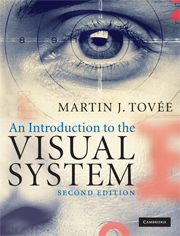Book contents
- Frontmatter
- Contents
- 1 Introduction
- 2 The eye and forming the image
- 3 Retinal colour vision
- 4 The organisation of the visual system
- 5 Primary visual cortex
- 6 Visual development: an activity-dependent process
- 7 Colour constancy
- 8 Object perception and recognition
- 9 Face recognition and interpretation
- 10 Motion perception
- 11 Brain and space
- 12 What is perception?
- References
- Index
- Plate sections
6 - Visual development: an activity-dependent process
Published online by Cambridge University Press: 05 June 2012
- Frontmatter
- Contents
- 1 Introduction
- 2 The eye and forming the image
- 3 Retinal colour vision
- 4 The organisation of the visual system
- 5 Primary visual cortex
- 6 Visual development: an activity-dependent process
- 7 Colour constancy
- 8 Object perception and recognition
- 9 Face recognition and interpretation
- 10 Motion perception
- 11 Brain and space
- 12 What is perception?
- References
- Index
- Plate sections
Summary
Variations on a theme
The development of the visual system is under the control of both genetic and environmental factors. The connections are refined and cut to fit on the basis of neural activity that is constantly flickering through the visual system from the retina. Following birth, it is environmental stimulation that elicits neural activity in the visual system. Cells in the retina, LGN and V1 of newborn, visually naïve monkeys and kittens have receptive field and response properties very much like those of the adults. However, there are differences in their visual systems, such as in layer 4 of V1 where the projections from the LGN terminate. At birth, the cells in layer 4 are driven by both eyes, as projections from the LGN spread over a wide region of layer 4, whereas in the adult a layer 4 cell is driven by either eye but not by both. The adult pattern of ocular dominance columns in layer 4 is established over the first 6 weeks of life, when the LGN axons retract to establish separate, alternating zones in layer 4 that are supplied exclusively by one eye or the other (Figure 6.1).
In early life, the connections of neurons in the visual system are susceptible to change and can be affected irreversibly by unbalanced neural activity passing through them. For example, closure of the lids of one eye during the first 3 months of life leads to blindness in that eye.
- Type
- Chapter
- Information
- An Introduction to the Visual System , pp. 89 - 100Publisher: Cambridge University PressPrint publication year: 2008



